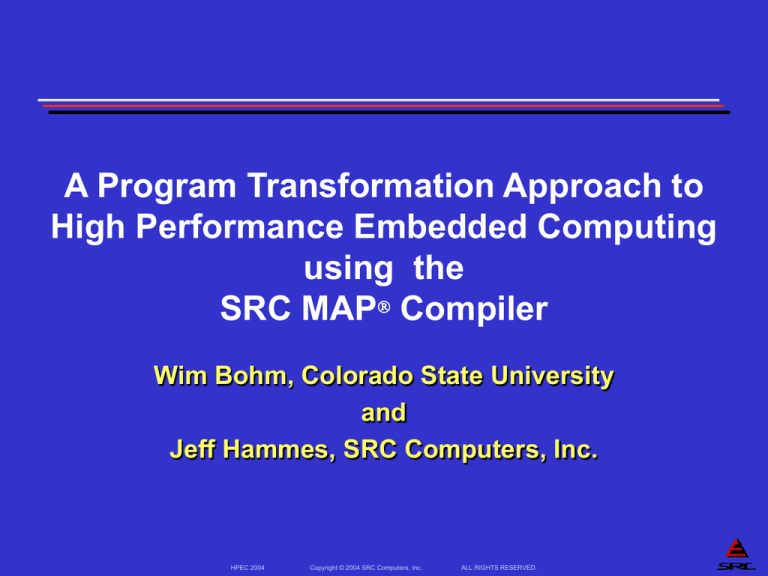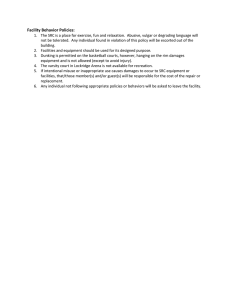
A Program Transformation Approach to
High Performance Embedded Computing
using the
SRC MAP Compiler
Wim Bohm, Colorado State University
and
Jeff Hammes, SRC Computers, Inc.
HPEC 2004
Copyright © 2004 SRC Computers, Inc.
ALL RIGHTS RESERVED.
SRC–6 MAP® System
SRC-6 MAP
– FPGA based High Performance architecture
– Fortran / C compiler for the whole system
One Node:
–
–
–
–
–
Microprocessor
MAP reconfigurable hardware board
SNAP μproc and MAP interconnected via DIM slot
GPIO ports allow connection to other MAPs
PCI-X can connect to other μprocs
Multiple configurations / implementations
– this talk: MAPstation - one node
MAP C Compiler
– Compiler generates both μproc and MAP code
– user partitions μproc, MAP tasks
HPEC 2004
Copyright © 2004 SRC Computers, Inc.
ALL RIGHTS RESERVED.
MAPstation
GPIO
Ports
MAP
SNAP™
Memory
P
PCI-X
MAP® board architecture
1400 MB/s
sustained
payload
MAP
1400 MB/s
sustained
payload
Control
FPGA
4800 MB/s
(6 x 64b)
Six Banks
Dual-ported
On-Board Memory
(24 MB)
4800 MB/s
(6 x 64b)
User
FPGA 0
108b
4800 MB/s
(6 x 64b)
4800 MB/s
192b
Dual-ported
Memory
(4 MB)
108b
GPIO
HPEC 2004
Direct Execution Logic (DEL) made
up of one or more User FPGAs
Control FPGA performs off board
memory access
Multiple banks of On-Board
Memory maximize local memory
bandwidth
GPIO ports allow direct MAP to
MAP chain connections or direct
data input
Multiple parallel data transports:
–
•
–
User
FPGA 1
–
28 MB @ 9.6 GB/s
Microprocessor Memory
•
ALL RIGHTS RESERVED.
648 KB @ 260 GB/s
On-Board SRAM Memories
•
–
264 KB @ 844 GB/s
Block SRAM in FPGA
•
2400 MB/s each
Copyright © 2004 SRC Computers, Inc.
Distributed SRAM in FPGA
8 GB @ 1400 MB/s
MAP Programmers View
1400 MB/s
sustained
payload
MAP
1400 MB/s
sustained
payload
Control
FPGA
4800 MB/s
(6 x 64b)
OBM
A
OBM
B
OBM
C
OBM
D
OBM
E
OBM
F
4800 MB/s
(6 x 64b)
4800 MB/s
(6 x 64b)
User
FPGA 0
108b
4800 MB/s
192b
Dual-ported
Memory
(4 MB)
108b
GPIO
HPEC 2004
User
FPGA 1
2400 MB/s each
Copyright © 2004 SRC Computers, Inc.
ALL RIGHTS RESERVED.
MAP C compiler
Pure C runs on the MAP !!
MAP C Compiler
– Intermediate form: dataflow graph of basic blocks
– Generated code: circuits
• Basic blocks in outer loops become special purpose
hardware “function units”
• Basic blocks in inner loop bodies are merged and become
pipelined circuits
Sequential semantics obeyed
– One basic block executed at the time
– Pipelined inner loops are slowed down to disambiguate
read/write conflicts if necessary
– MAP C compiler identifies (cause of) loop slowdown
HPEC 2004
Copyright © 2004 SRC Computers, Inc.
ALL RIGHTS RESERVED.
Execution Modes
DEBUG Mode
–
–
–
–
code runs on workstation
allows debugging ( printf )
allows most performance tuning (avoiding loop slow downs)
user spends most time here
Two SIMULATION Modes
– Dataflow level and Hardware level
– mostly used by compiler / hardware function unit developers
– very fine grain information
HARDWARE Mode
– final stage of code development
– allows performance tuning using timer calls
HPEC 2004
Copyright © 2004 SRC Computers, Inc.
ALL RIGHTS RESERVED.
Transformational Approach
Start with pure C code
Partition Code and Data
– distribute data over OBMs and Block RAMs
– distribute code over two FPGAs
• only one chip at the time can access a particular OBM
• MPI type communication over the bridge
Performance tune (removing inefficiencies)
–
–
–
–
avoid re-reading of data from OBMs using Delay Queues
avoid read / write conflicts in same iteration
avoid multiple accesses to a memory in one iteration
avoid OBM traffic by fusing loops
Today’s transformation is tomorrow’s compiler
optimization
HPEC 2004
Copyright © 2004 SRC Computers, Inc.
ALL RIGHTS RESERVED.
How to performance tune: Macros
C code can be extended using macros allowing
for program transformations that cannot be
expressed straightforwardly in C
Macros have semantics unlike C functions
–
–
–
–
–
have a period (#clocks between inputs)
have a pipeline delay (#clocks between in and output)
MAP C compiler takes care of period and delay
can have state (kept between macro calls)
two types of macros
• system provided
– compiler knows their period and delay
• user provided (written in e.g. Verilog )
– user needs to provide period and delay
HPEC 2004
Copyright © 2004 SRC Computers, Inc.
ALL RIGHTS RESERVED.
Two Case Studies
Wavelet Versatility Benchmark
– Image processing application (wavelet compression)
– Part of DARPA/ITO ACS (Adaptive Computing Systems)
benchmark suite
– Versatile: Four phases of different computational nature
1: wavelet transform:
2: quantization:
3: run length encoding:
4: Huffman encoding:
window access, multiple outputs
sum, min, max reductions
while loop, irregular output
table lookups
Gauss Seidel Linear Equation Solver
– Numerical (Floating Point) kernel
– Iterative nature:
non-perfect loop structure
– Many applications
HPEC 2004
Copyright © 2004 SRC Computers, Inc.
ALL RIGHTS RESERVED.
Wavelet Versatility Benchmark
Wavelet transform
LL HL
– Applied three times
• Second and third passes use
upper left quadrant of
previous pass
LH HH
LH
HL
HL
HH
– L: Low pass filter (average)
– H: High pass filter (derivative)
Wavelet does not compress
but enables compression in
further stages (many 0s in H)
LH
– Quantization
– Run-Length Encoding
– Huffman Encoding
HPEC 2004
Copyright © 2004 SRC Computers, Inc.
ALL RIGHTS RESERVED.
HH
First wavelet step
HPEC 2004
Copyright © 2004 SRC Computers, Inc.
ALL RIGHTS RESERVED.
Second wavelet step
HPEC 2004
Copyright © 2004 SRC Computers, Inc.
ALL RIGHTS RESERVED.
Final wavelet step
HPEC 2004
Copyright © 2004 SRC Computers, Inc.
ALL RIGHTS RESERVED.
MAP C Algorithm
One 5x5 window stepping by 2 in both directions
– Computes LL, LH, HL, and HH simultaneously
LL
HL
LH
HH
– Inefficiency: naive first implementation re-accesses
overlapping image elements
HPEC 2004
Copyright © 2004 SRC Computers, Inc.
ALL RIGHTS RESERVED.
Efficient Window Access
Keep data on chip using Delay Queues
– E.g. 16 deep (using efficient hardware SLR16 shifters)
9 points in stencil
8 have been seen
before
Simplified example:
– 3x3 window
• stepping 1 by 1
• in column major order
Per window
the leading
point should
be the only
data access.
– image 16 deep
• general case divides
the Image in 16 deep strips
input array traversal
HPEC 2004
Copyright © 2004 SRC Computers, Inc.
ALL RIGHTS RESERVED.
Delay Queues 1
Compute f(x1,x2,..x9)
Data access input(i)
f7
f4
f1
f8
f5
f2
f1
f6
f0
f1
f1
f1
f1
f1
f1
f1
f1
f1
f1
f1
f1
f1
f1
f1
f1
f1
f1
f1
f1
f1
f1
f1
f1
f1
f1
f1
f1
f1
f1
f1
f0
HPEC 2004
two 16–word Delay Queues
shift and store previous columns
Copyright © 2004 SRC Computers, Inc.
ALL RIGHTS RESERVED.
Delay Queues 2
Compute f(x1,x2,..x9)
Data access input(i)
f7
f4
f1
f8
f5
f0
f1
f6
f1
f1
f1
f1
f1
f1
f1
f1
f1
f1
f1
f1
f1
f1
f1
f1
f1
f1
f1
f1
f1
f1
f1
f1
f1
f1
f1
f1
f1
f1
f1
f0
f1
HPEC 2004
Copyright © 2004 SRC Computers, Inc.
ALL RIGHTS RESERVED.
Delay Queues 3
Compute f(x1,x2,..x9)
Data access input(i)
f7
f4
f0
f8
f5
f1
f1
f6
f2
f1
f1
f1
f1
f1
f1
f1
f1
f1
f1
f1
f1
f1
f1
f1
f1
f1
f1
f1
f1
f1
f1
f1
f1
f1
f1
f1
f1
f1
f0
f1
f2
HPEC 2004
Copyright © 2004 SRC Computers, Inc.
ALL RIGHTS RESERVED.
Delay Queues 4
Compute f(x1,x2,..x9)
Data access input(i)
f7
f4
f1
f8
f5
f2
f1
f6
f3
f1
f1
f1
f1
f1
f1
f1
f1
f1
f1
f1
f1
f1
f1
f1
f1
f1
f1
f1
f1
f1
f1
f1
f1
f1
f1
f1
f1
f0
f1
f2
f3
HPEC 2004
Copyright © 2004 SRC Computers, Inc.
ALL RIGHTS RESERVED.
Delay Queues 5
Compute f(x1,x2,..x9)
Data access input(i)
f7
f4
f2
f8
f5
f3
f1
f6
f4
f1
f1
f1
f1
f1
f1
f1
f1
f1
f1
f1
f1
f1
f1
f1
f1
f1
f1
f1
f1
f1
f1
f1
f1
f1
f1
f1
f0
f1
f2
f3
f4
HPEC 2004
Copyright © 2004 SRC Computers, Inc.
ALL RIGHTS RESERVED.
… Delay Queues 16
Compute f(x1,x2,..x9)
Data access input(i)
f7
f4
f13
f8
f5
f14
f1
f0
f15
f1
f1
f1
f1
f1
f1
f1
f1
f1
f1
f1
f1
f1
f1
f1
f0
f0
f1
f2
f3
f4
f5
f6
f7
f8
f9
f10
f11
f12
f13
f14
f15
HPEC 2004
Copyright © 2004 SRC Computers, Inc.
ALL RIGHTS RESERVED.
Delay Queues 17
Compute f(x1,x2,..x9)
Data access input(i)
f7
f4
f14
f8
f0
f15
f1
f0
f16
f1
f1
f1
f1
f1
f1
f1
f1
f1
f1
f1
f1
f1
f1
f0
f0
f1
f2
f3
f4
f5
f6
f7
f8
f9
f10
f11
f12
f13
f14
f15
f16
HPEC 2004
Copyright © 2004 SRC Computers, Inc.
ALL RIGHTS RESERVED.
Delay Queues 18
Compute f(x1,x2,..x9)
Data access input(i)
f7
f0
f15
f8
f0
f16
f1
f1
f17
f1
f1
f1
f1
f1
f1
f1
f1
f1
f1
f1
f1
f1
f0
f0
f1
f2
f3
f4
f5
f6
f7
f8
f9
f10
f11
f12
f13
f14
f15
f16
f17
HPEC 2004
Copyright © 2004 SRC Computers, Inc.
ALL RIGHTS RESERVED.
…Delay Queues 32
Compute f(x1,x2,..x9)
Data access input(i)
f7
f13
f29
f8
f14
f30
f1
f15
f31
f0
f1
f2
f3
f4
f5
f6
f7
f8
f9
f10
f11
f12
f13
f14
f15
f16
f17
f18
f19
f20
f21
f22
f23
f24
f25
f26
f27
f28
f29
f30
f31
HPEC 2004
Copyright © 2004 SRC Computers, Inc.
ALL RIGHTS RESERVED.
…Delay Queues 35
Compute f(x1,x2,..x9)
Data access input(i)
f0
f16
f32
f1
f17
f33
f2
f18
f34
f3
f4
f5
f6
f7
f8
f9
f10
f11
f12
f13
f14
f15
f16
f17
f18
f19
f20
f21
f22
f23
f24
f25
f26
f27
f28
f29
f30
f31
f32
f33
f34
HPEC 2004
Copyright © 2004 SRC Computers, Inc.
ALL RIGHTS RESERVED.
Delay Queues 36
Compute f(x1,x2,..x9)
Data access input(i)
f1
f17
f33
f2
f18
f34
f3
f19
f35
f4
f5
f6
f7
f8
f9
f10
f11
f12
f13
f14
f15
f16
f17
f18
f19
f20
f21
f22
f23
f24
f25
f26
f27
f28
f29
f30
f31
f32
f33
f34
f35
HPEC 2004
Copyright © 2004 SRC Computers, Inc.
ALL RIGHTS RESERVED.
Delay Queues 37
Compute f(x1,x2,..x9)
Data access input(i)
f2
f18
f34
f3
f19
f35
f4
f20
f36
f5
f6
f7
f8
f9
f10
f11
f12
f13
f14
f15
f16
f17
f18
f19
f20
f21
f22
f23
f24
f25
f26
f27
f28
f29
f30
f31
f32
f33
f34
f35
f36
HPEC 2004
Copyright © 2004 SRC Computers, Inc.
ALL RIGHTS RESERVED.
Delay Queues: Performance
3x3 window access code
512 x 512 pixel image
Routine Style
Number
of clocks
Comment
Straight Window
2,376,617
close to 9 clocks per iteration
2,340,900: the difference
is pipeline prime effect
Delay Queue
279,999
close to1 clock per iteration
262144: theoretical limit
FPGA timing behavior is very predictable
HPEC 2004
Copyright © 2004 SRC Computers, Inc.
ALL RIGHTS RESERVED.
Wavelet Benchmark cont’
Rest of the code:
– Quantize each block in 16 bins per block
– Run Length Encode zeroes
• Occur frequently in derivative blocks
– Huffman Encode
Three transformations
– Fuse the three loops avoiding OBM traffic
– Use accumulator macros to avoid R / W conflicts
• (see Gauss Seidel case study)
– Task parallelize the complete code over two FPGAs
HPEC 2004
Copyright © 2004 SRC Computers, Inc.
ALL RIGHTS RESERVED.
Versatility Benchmark: Performance
512x512 image
Bit true results as compared to reference code
Full implementation: All phases run on FPGAs
Reference code compiled using Intel C compiler
executed on 2.8 GHz Pentium IV: 76.0 milli-sec
MAP execution time:
2.0 milli-sec
MAP Speedup vs. Pentium
38
HPEC 2004
Copyright © 2004 SRC Computers, Inc.
ALL RIGHTS RESERVED.
Gauss Seidel Iterative Solver
Scientific Floating Point Kernel (single precision for now)
Works for diagonally dominant matrices
Some math manipulation to create an iterative solver:
Ax = b (L+D+U)x = b x = D-1b-D-1(L+U)x xn+1 = (Ab)xn
while(maxerror > tolerance) {
// do a next iteration
maxerror = 0.0;
for(i=0;i<n;i++) {
// compute new x[ i ]
sxi = x[ i ];
xi = 0.0;
for(j=0;j<n+1;j++)
xi += Ab[ i*COL+j ] * x[ j ];
// in product
error = abs(xi – sxi);
}
maxerror = max(maxerror, error);
}
HPEC 2004
Copyright © 2004 SRC Computers, Inc.
ALL RIGHTS RESERVED.
Pure C
OBM
A
i
User Logic
Chip
j
Ab
Abij
Algorithm in
logic
for i
X
BRAM
for j
ld xi
i
ld Abij
ld xj
xi
old
xi
x
+
xj
reg
compute
errori
HPEC 2004
Loop Slowdown
caused by
Read/Write
conflict
new
xi
st xi
Copyright © 2004 SRC Computers, Inc.
ALL RIGHTS RESERVED.
Accumulator Macro
OBM
A
i
Ab
j
Abij
for i
X
BRAM
for j
ld xi
i
ld Abij
ld xj
xi
old
xi
x
hw
accumulator
xj
compute
errori
HPEC 2004
new
xi
Hardware
Accumulator
macro
resolves
read / write
conflict
st xi
Copyright © 2004 SRC Computers, Inc.
ALL RIGHTS RESERVED.
Packing the data
OBM A
j j+1
Abij
Abij+1
i
64 bit OBM word
can contain two floats
for i
X
BRAM
for j
cond_ld
xi
xi
i
i
j
j
odd even
ld xj xj+1
ld Abij Abij+1
x
xj
x
This requires unrolling j loop
which now accesses
Abi j Abi j+1 Xj Xj+1
+
old
xi
hw
accumulator
compute
errori
HPEC 2004
new
xi
To avoid multiple Block
RAM reads, X is stripe
partitioned over two Block
RAM arrays
cond_store
xi
Copyright © 2004 SRC Computers, Inc.
ALL RIGHTS RESERVED.
Pack Abstracted
OBM A
j j+1
Abij
Abij+1
i
for i
X
BRAM
cond_ld
xi
for j
xi
i
j
i
j
old
xi
xj
new
compute xi
errori
cond_store
xi
odd even
HPEC 2004
mac 2ij
Copyright © 2004 SRC Computers, Inc.
ALL RIGHTS RESERVED.
Data Partitioned into 3 blocks
OBM A
OBM B
j j+1
b
OBM C
j j+1
2b
i
i+b
i+2b
b-1
2b-1
3b-1
j j+1
for i
X
BRAM
xi
i
for j
i
i+b
i+b
j
j
i+2b
cond_load
xi, xi+b, xi+2b
i+2b
odd even
old
xi
mac2 i,j
mac2 i+b,j
mac2
i+2b,j
j loop now
computes
new
xi
xj
compute
errori
HPEC 2004
Ab is now
row-block
distributed
(3 blocks in
3 OBMs)
3 new Xs
cond_store
xi, xi+b, xi+2b
Copyright © 2004 SRC Computers, Inc.
ALL RIGHTS RESERVED.
Two FPGAs
OBM A
X
BRAM
OBM B
OBM C
for i
cond_ld
xi, xi+b,
xi+2b
OBM D
X
BRAM
for j
i
i
i+b
i+b
j
j
j
i+2b
i+2b
i+2b
i
i
i+b
i+b
j
i+2b
mac2
i,j
mac2
i+b,j
mac2
i+2b,j
compute
error
User
Chip 0
OBM E
OBM F
for i
cond_ld
xi, xi+b,
xi+2b
for j
mac2
i,j
mac2
i+b,j
compute
error
Store &
compute error
Store &
compute error
User
Chip 1
Ab is row block distributed (6 blocks in 6 OBMs)
The j-loops perform 24 Floating Ops in each clock
FPGA0 and FPGA1 exchange 3 Xs, 1 error
HPEC 2004
Copyright © 2004 SRC Computers, Inc.
ALL RIGHTS RESERVED.
mac2
i+2b,j
Gauss Seidel Performance
n=500
27
n=1000
6
n=2000
7
Pentium IV
(2.8 GHz )
0.19 secs
65 MFlops
0.48 secs
26 MFlops
1.90 secs
28 MFlops
MAP
0.013 secs
830 MFlops
0.008 secs
1.23 GFlops
0.031 secs
1.65 GFlops
14
57
60
No. Iterations
MAP speedup
vs. Pentium
HPEC 2004
Copyright © 2004 SRC Computers, Inc.
ALL RIGHTS RESERVED.
Conclusions
High Level Algorithmic Language runs on FPGA based
HPEC system
– DEBUG Mode allows most development on workstation
We can apply standard software design methodologies
– stepwise refinement
• currently using macros
• later using (user directed?) compiler optimizations
Bandwidth is key to FPGA performance
– Often, more operations are available in the FPGA fabric than
can be supplied by the available off-chip I/O
– FPGA capability is improving rapidly
Currently speedups ~50 vs. Pentium IV
Future: Multiple MAPs
– More complex, streaming applications
HPEC 2004
Copyright © 2004 SRC Computers, Inc.
ALL RIGHTS RESERVED.


